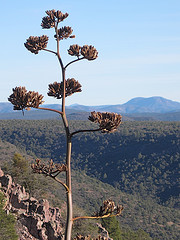When an Endangered Species Isn’t
By: Amos S. Eno
Posted on:08/23/2011 Updated:02/09/2016Tales of Sonora Chub, Lesser Long-nosed Bats, and the Cactus Ferruginous Pygmy Owl
Jim Chilton appreciates wildlife, but now we begin the tales of his tangles with the Endangered Species Act and its advocates.
“The Center for Biological Diversity accused me of endangering the Sonora chub through grazing and also said the Lesser Long-nosed Bat was being harmed by grazing,” says Jim.
Conducting his Own Research
But Jim Chilton doesn’t take the word of an advocacy group, or even Fish & Wildlife Service biologists. He does his own research! After consulting the scientific literature, he found that the Lesser Long-nosed Bat is, according to Jim, “one of many species that should never have been listed as endangered. The people who got it listed in the first place looked in the wrong places at the wrong time of year.
word of an advocacy group, or even Fish & Wildlife Service biologists. He does his own research! After consulting the scientific literature, he found that the Lesser Long-nosed Bat is, according to Jim, “one of many species that should never have been listed as endangered. The people who got it listed in the first place looked in the wrong places at the wrong time of year.
“I have journal articles on this bat from two experts, both of whom object to the listing. Even some people in the Forest Service don’t believe it’s warranted. The best scientists say it was improperly listed. Other noted scientists say it’s not limited in its food source: the sweet nectar of agave (century) plants. We actually have very few agaves on our property. In consulting with the Forest Service, the US Fish & Wildlife Service said we could only graze half of the ranch during blooming season, which is easy to do since we’re always grazing only about one-third of it. But the listing is wrong,” he maintains, "the experts say people claiming the bat had disappeared looked for it in bat caves at the wrong time of the year. Besides, the only recorded specimen of this species was over 20 years ago about 40 miles east of our ranch.”
The Sonora Chub and Cactus Ferruginous Pygmy Owl
As for the Sonora chub, Jim found there’s only one place in the United States where it’s known to exist: on a ranch to the east of his, in Sycamore canyon, fenced off and excluded from grazing by the Forest Service. Jim says, “When I got to studying the Sonora chub, I found it exists in three major rivers in northern Mexico, and 99.7% of all the fish in those rivers are Sonora chub. They’re not endangered, only rare in the U.S. I believe Sonora chub should not have been listed in the US. It was another case of listing a species at the extreme northern end of its range just to seize control of border ranching.”
Jim, of course, maintains that “grazing, when done at light to moderate levels like I do it, and everybody else does it and the Forest Service requires you to do it - actually impacts vegetation positively. We have about 30 different species of native grasses on our land that have evolved over hundreds of thousands of years with grazers. These grasses are stimulated and maintained by managed grazing. One spot on our ranch has a fenced-off area called an exclosure, and for 40 years it’s had no cattle. A grass monoculture - almost exclusively non-native Lehmann lovegrass - has developed inside the fence. Whereas outside, a variety of deep-rooted native grasses thrive, inside the fence there’s only one species with a root structure very near the surface, which is not as good for holding water in the soil or surviving drought.”
“There have been a number of other listings that should never have taken place, for example the Cactus Ferruginous Pygmy Owl. The Center for Biological Diversity got it listed, and the Fish & Wildlife Service put tremendous pressure on everyone in Southern Arizona to protect it. There were only 30 or 40 of these owls in the U.S., but again, they’re abundant in Mexico. I concluded it’s not a fair listing. I felt vindicated in that belief when the U.S. district court delisted the Cactus Ferruginous Pygmy Owl. The listing was not science; it was political science.”
Next, the Service listed the Chiricahua Leopard Frog, and Jim studied that one too.
An upcoming blog post will explain what happened when Jim concluded this listing was merited and also what happens when a rancher turns a litigator's tactics against itself. To catch all of our blog posts each week, subscribe to our RSS feed then click "add bookmark" at bottom right.
 Sign In
Sign In
 Sign In
Sign In
